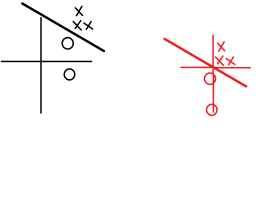I keep coming across this idea in the context of linear classifiers that an affine hyperplane can be made linear by incorporating an additional dimension.
1) This feels like overkill to me. Why not just assume an appropriate translation of the hyperplane and all data points such that the hyperplane passes through the origin within its original dimensions?
2) Does anyone have an animation to illustrate the geometry of moving the hyperplane and data points from 2 to 3 dimensions in this way? I can't quite visualize it from the 2D drawing on the chalkboard. The closest thing I found was this video, but I think it's something significantly different.
1) This feels like overkill to me. Why not just assume an appropriate translation of the hyperplane and all data points such that the hyperplane passes through the origin within its original dimensions?
2) Does anyone have an animation to illustrate the geometry of moving the hyperplane and data points from 2 to 3 dimensions in this way? I can't quite visualize it from the 2D drawing on the chalkboard. The closest thing I found was this video, but I think it's something significantly different.

